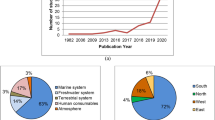Abstract
The quantitative concentrations of 21 congeners of polychlorinated biphenyls and 16 priority polycyclic aromatic hydrocarbons were studied in bottom sediments of the Usa River, the largest Pechora’s tributary, and its tributaries located in the central part of Timan-Pechora petroleum province. In accordance with the classification of the regional and international standards, the pollution degree of bottom sediments by organic compounds of those classes was evaluated. Pollution profiles were examined and the character of the dominating source of polychlorinated biphenyls and polycyclic aromatic hydrocarbons for bottom sediments in the region under study was identified. Key words: bottom sediments, polychlorinated biphenyls, profiles of polycyclic aromatic hydrocarbons, petrogenic, pyrogenic pollution source.
Similar content being viewed by others
References
Brodskii, E.S., Systems Approach to Identifying Organic Compounds in Complex Mixtures of Environmental Pollutants, Zhurn. analit. Khimii, 2002, vol. 57, no. 6, pp. 585–591.
Lukin, A.A., Dauval’ter, V.A., and Novoselov, A.P., Ekosistema r. Pechory v sovremennykh usloviyakh (Pechora River Ecosystem under Current Conditions), Apatity: Inst. problem promyshlennoi ekologii Severa, 2000, pp. 61–72.
Maistrenko, V.N. and Klyuev, N.A., Ekologo-analiticheskii monitoring stoikikh organicheskikh zagryaznitelei (Ecological-Analytical Monitoring of Stable Organic Pollutants), Moscow: BINOM, 2004.
Nemirovskaya, I.A., Anthropogenic and Natural Hydrocarbons in White Sea Ecosystem, Mater. IX mezhdunar. konf. “Problemy izucheniya, ratsional’nogo ispol’zovaniya i okhrany resursov Belogo morya” (Proc. IX Intern. Conf. “Issues of Studying, Rational Use, and Protection of White Sea Resources), Petrozavodsk, 2005, pp. 244–248.
Normy i kriterii otsenki zagryaznennosti donnykh otlozhenii v vodnykh ob“ektakh Sankt-Peterburga, regional’nyi normativ (Standards and Assessment Criteria of Bottom Sediment Pollution in Water Bodies of St.Petersburg, Regional Standard), St. Petersburg, 1996.
Patin, S.A., Ekologicheskie problemy osvoeniya neftegazovykh resursov morskogo shel’fa (Ecological Problems of Oil and Gas Resources Development on Sea Shelf), Moscow: VNIRO, 1997.
Petrova, V.I., Batova, G.I., Kursheva, A.V., et al., Geochemistry of Polycyclic Aromatic Hydrocarbons in the Bottom Sediments of the Eastern Arctic Shelf, Okeanologiya, 2008, vol. 48, no. 2, pp. 215–223 [Oceanol. (Engl. Transl.), vol. 48, no. 2, pp. 196–203)].
Khudolei, V.V., Livanov, G.A., Gusarov, E.E., et al., Stoikie organicheskie zagryazniteli. Puti resheniya problem (Stable Organic Pollutants. Ways to Solve the Problems), St. Petersburg: St.-Peterb. Gos. Univ., 2002.
Dahle, S., Savinov, V., Petrova, V., et al., Polycyclic Aromatic Hydrocarbons in Norwegian and Russian Arctic Marine Sediments: Concentrations, Geographical Distribution and Sources, Norwegian J. Geol., 2006, vol. 86, pp. 41–50.
Falandysz, J. and Strandberg, B., Persistent Organochlorine Compounds in Sludge and Sediments from the Gdansk Region, Baltic Sea, Polish J. Environ. Stud., 2004, vol. 13, no. 2, pp. 133–138.
Hwang, Hyun-Min., Wade, T.L., and Sericano, J.L., Concentrations and Source Characterization of Polycyclic Aromatic Hydrocarbons in Pine Needles from Korea, Mexico, and US, Atmospheric Environ., 2003, vol. 37, no. 16, pp. 2259–2267.
Isosaari, P., Pajunen, H., and Vartiainen, T., PCDD/F and PCB History in Dated Sediments of a Rural Lake, Chemosphere, 2002, vol. 47, no. 6, pp. 575–583.
Savinov, V.M., Savinova, T.N., Carrol, J., et al., Polycyclic Aromatic Hydrocarbons in Sediments of the White Sea, Russia, Mar. Poll. Bul., 2000, vol. 40, no. 10, pp. 807–818.
Seegal, R.F., Epidemiological and Laboratory Evidence of PCB-Induced Neurotoxicity, Crit. Rev. Toxicol., 1996, vol. 26, pp. 707–737.
Stephen de Mora, Villeneuve J.-P., Sheikholeslami M.R. et al. Organochlorinated Compounds in Caspian Sea Sediments, Mar. Poll. Bull., 2004, vol. 48, pp. 30–43.
Yunker, M.B., Macdonald, R.W., Vingarzan, R., et al., PAHs in the Fraser River Basin: a Critical Appraisal of PAH Ratios as Indicators of PAH Source and Composition, Org. Geochem., 2002, vol. 33,Is. 4, pp. 489–515.
Yunker, M.B. and Snowdon, L.R., MacDonald R.W. et al. Polycyclic Aromatic Hydrocarbon Composition and Potential Sources for Sediment Samples from the Beaufort and Barents Seas, Environ. Sci. Technol., 1996, vol. 30, no. 4, pp. 1310–1320.
US EPA. Exposure and Human Health Reassessment of 2.3,7.8-Tetrachlorodibenzo-P-Dioxin (TCDD) and Related Compounds, Washington, DC: EPA/600/P-00/001Ab, 2000.
Author information
Authors and Affiliations
Additional information
Original Russian Text © Z.A. Zhakovskaya, V.N. Petrova, L.O. Khoroshko, G.I. Kukhareva, A.A. Lukin, 2010, published in Vodnye Resursy, 2010, Vol. 37, No. 1, pp. 78–86.
Rights and permissions
About this article
Cite this article
Zhakovskaya, Z.A., Petrova, V.N., Khoroshko, L.O. et al. Polychlorinated biphenyls and hydrocarbons in bottom sediments of Pechora Basin Rivers. Water Resour 37, 75–83 (2010). https://doi.org/10.1134/S0097807810010070
Received:
Published:
Issue Date:
DOI: https://doi.org/10.1134/S0097807810010070




